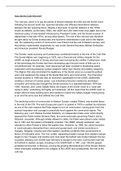How did the Cold War end?
The cold war, which is to say the period of tension between the USA and the Soviet Union
following the second world war, spanned decades and affected international relations
between the two opposing blocs. Despite a brief span of warmer relations in the 1970s
known as detente, by the early 1980s, the USSR and USA were rivals once again due to the
American policy of rearmament introduced by President Carter, and the Soviet invasion of
Afghanistan in the late 1970s, among other factors. The end of the cold war was therefore
brought about by Soviet bureaucratic and economic weaknesses in part due to the Afghan
war, the weakening control of communism over Poland and the rest of Eastern europe, and
the policies implemented respectively by new soviet General Secretary Mikhail Gorbachev
and American president Ronald Reagan.
The Soviets’ weak economy and bureaucracy contributed heavily to the end of the Cold War.
The Soviet-Afghan war, beginning in 1979, was a financial and military disaster for the
USSR, as huge amounts of money and lives were lost during the conflict. Furthermore, most
of the technology the Soviets had been developing upto this point were of little use in a
conventional war: for example, most resources had been invested in developing space
exploration and long-distance nuclear weapons rather than infantry and artillery weaponry.
The Afghan War also diminished the legitimacy of the Soviet union as a powerful political
union and weakened the image of the Soviet Red Army and communism. The Chernobyl
nuclear accident in 1986 was also an economic catastrophe for the USSR, additionally
creating a mistrust of nuclear power. Low industrial production marked by alcoholism,
corruption and inertia also brought the Soviet economy to a standstill between 1979 and
1985. Historian John Lewis Gaddis likens the empire of the Soviet Union to a “sand pile
ready to slide,” underlining its fragility and weakness. All this meant that the USSR could no
longer afford to keep building arms and needed to reduce the military budget, helping bring
to an end the arms race that defined the Cold War.
The declining control of communism in Eastern Europe, notably Poland, was another factor
in the end of the CW. The visit of pope john paul II to poland in 1979 is credited by historians
as one of the main reasons the Poles began to turn on communism, having given them the
spiritual inspiration and courage to peacefully revolt against the communist regime. The
following year, Lech Walesa founded Solidarity, an independent trade union which directly
opposed the Polish United Workers Party, the communist party governing Poland, led by
Wojciech Jaruzelski. Although initially allowed to strike, the Poles were placed under martial
law in 1981 and the leaders of Solidarity arrested. The USSR, already weakened, was
reluctant to allow Poland to leave the eastern bloc. However, by 1989, the velvet revolution
in czechoslovakia dismantled their communist government, and similar revolutions in
Hungary, Bulgaria, romania and other eastern countries overthrew their governments in
favour of multi-party ones. The ‘iron curtain’ separating Eastern europe from western europe
began to rise; Hungary and Austria even took apart the barbed wire border between the two
countries, allowing over 30,000 east Germans to escape to the west. Communism had lost
its foothold in eastern europe, including in the USSR itself: in 1991, over 100,000 people
protested communism in Moscow, proving the growing discontentment of the Soviet citizens,
which eventually contributed to the collapse of the USSR and consequently, the end of the
cold war.




